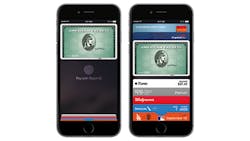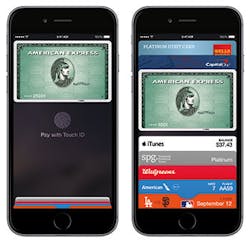In my May 12th blog Whatever Happened to NFC and Mobile Payments? I expressed some doubts.
about the future of payment systems using NFC given the poor adoption to date. But now that Apple has committed to NFC and launched their own payment system called Apple Pay it appears that the whole mobile payment movement will be energized.
In case you are not familiar, NFC means near field communications. It is an extremely short range wireless technology. The typical maximum range is about 20 cm but a couple inches at most is probably more realistic. NFC uses the near field (as opposed to the far field) of the electromagnetic energy. The near field is mainly the magnetic field close to the antenna so that two NFC devices act like windings on a transformer. The transmit antenna is the primary winding and the receiving antenna is the secondary winding.
NFC operates at 13.56 MHz, one of the license-free industrial-scientific-medical (ISM) radio frequencies. The antenna is fairly large coil on a ferrite core. NFC uses ASK with a base data rate of 106 kb/s with higher rates to 212 kb/s and 424 kb/s. Two NFC radios automatically hook up when they get within range of one another. Besides payments, NFC is good for things like secure building entry, parking, vending machines, bus or subway payment, and the like. Because of its short range, it is hard to hack making it very secure.
Many Android phones have included NFC for over a year and a number of payment systems were activated. (e.g. Google Wallet) However, the retail merchants never massively adopted these systems. With the new Apple Pay system, it is hoped that the retailers will reconsider and install NFC payment terminals. Customers pay by just waving their iPhones near the reader or tapping it.
Apple obviously wants to get in on the transaction fees that usually accompany such payments. The annual credit and debit card sales run several trillion dollars so even a small percentage will greatly boost Apple’s income. Apple has already made agreements and arrangements with multiple retailers such as McDonalds, Whole Foods, Macy’s and Walgreen. It also has deals with VISA, Mastercard and American Express. More of the larger retailers like Walmart, Target and Home Depot would make it even better.
The big question is whether the public will go crazy for smartphone NFC payments. Credit cards and cash still rule. Many fear that NFC payment is not secure. Actually it is more secure given the short range of the technology and the fact that the Apple Pay system encrypts each transaction with a one-time code designed to prevent ID theft and other corruptions. Overcoming the security fear is key to making NFC payment ubiquitous. Some even predict that eventually 50 percent of payments will be with a smartphone. And practically everyone now has a smartphone. But most not with NFC. Yet.
About the Author

Lou Frenzel Blog
Communications Technology
Click here to find more of Lou's articles on Electronic Design.

